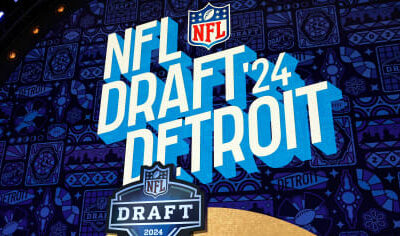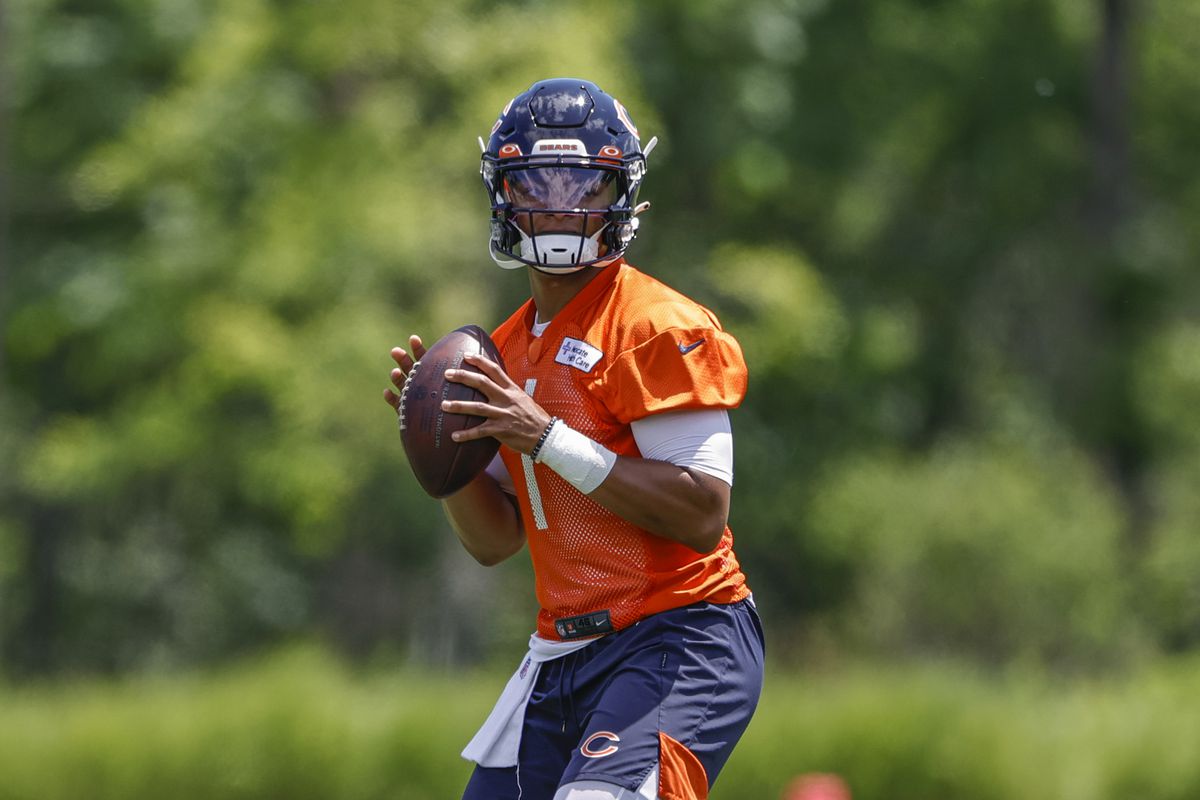
A new era of Chicago Bears football may be closer than NFL fans think.
It took two blockbuster trades, several coaching changes and the departure of quarterback Mitchell Trubisky to get there, but the Chicago Bears are seeing new light for the first time since their 12-4 regular season extravaganza in 2018.
Even with two years of shortcomings, injuries, disagreements between the coaching staff and the front office, and everything in between, the team still features plenty of talent and reasons to keep Bears fans on their feet in Soldier Field.
The seemingly endless clutch interceptions from safety Eddie Jackson and tsunami of sacks from defensive linemen Akiem Hicks and Khalil Mack have dipped, the Trubisky era may be over, and the wacky-but-incredible plays of head coach Matt Nagy that stunned the NFL world may be no more, but fans around the Chicagoland area can still be confident of one thing: The Chicago Bears are still a playoff team.
Nagy will enter his fourth year under the Bears’ coaching helm in what could arguably be one of the biggest tests in his coaching career. The 43 year old coach, who excelled as the offensive coordinator for the Kansas City Chiefs, has gone 16-17 since his electrifying 2018 season. The former quarterback was brought in to bring new light to the Bears’ offense and foster the former No. 2 overall pick in Trubisky’s growth.
His offense may not be what it once was, but Nagy has been able to adapt to the situation given to him, benching Trubisky for quarterback Nick Foles in week 3 and handing play calling duties to offensive coordinator Bill Lazor against the Vikings in week 10.
While the Bears are playoff-calibre, they still have a ways to go in addressing their most pressing questions before hoisting the Lombardi trophy with their current core.
The listed questions are in no particular order.
The Offense
Just like many years prior, Chicago’s offense will be the main catalyst for determining their success in 2021.
Without question, the Bear’s front office has addressed some of the offense’s most glaring needs: Drafting two mammoth linemen for length and strength at the tackle spots, bringing in speedy receivers like Damiere Byrd and Marquese Goodwin to better fit a Matt Nagy offense, and, most importantly, the Bears drafted quarterback Justin Fields.
While arguably more well-rounded than last year’s, the offense itself has its own array of important questions the coaching staff and front office will have to answer during training camp.
Will the new editions on the offensive line be enough to create an effective pocket and a productive run game?
The Bear’s offensive line needed a tuneup.
Last year, the offense couldn’t get a reliable amount of blockers in front of running back David Montgomery to provide an effective running game. The Bears ranked 25th in rushing yards per game (102.9), according to ESPN. Their passing game struggled as linemen missed blocking assignments and sent Trubisky and Foles scrambling for their lives while looking for open options, blocking for a passing offense that ranked 22nd in the NFL (228.4 ypg).
General manager Ryan Pace went out of his way and then some to retool and revamp a floundering offensive line in the offseason.
In free agency, Chicago picked up tackle Elijah Wilkinson, rookie guard Dieter Eiselen, and center Adam Redmond to build depth and bulk up a relatively inexperienced offensive line.
In the draft, the Chicago Bears traded up to select tackle Teven Jenkins out of Oklahoma State University, a three-year starter who played on both sides of the line. Chicago also snapped up Larry Borom, a two-year starter at the University of Missouri to pair with Jenkins at the right tackle.
Still, Bears fans may still have some reason to be skeptical of a new-look offensive line. Pro Football Focus placed Chicago at No. 27 in the league for offensive line rankings, citing the “game of musical chairs” in the interior and the lack of high-ranking tackles to potentially protect Fields and quarterback Andy Dalton.
While the line’s rotation may be more solidified going into this season, it will be up to the younger editions, as well as Chicago-mainstays in center Cody Whitehair and guard James Daniels to find cohesiveness and provide an answer once-and-for-all to Chicago’s blocking issues.
Is the wide receiver core competitive enough for Chicago’s quarterbacks to succeed?
No matter what, Fields won’t be able to hit the ground running without a solid receiving core.
Last year, Chicago’s receivers were young but promising. The oldest projected starter, according to Pro Football Reference, was now-27 year old receiver Allen Robinson. Two rookies from last year’s draft, tight end Cole Kmet and receiver Darnell Mooney, managed to break the starting lineup last year towards the end of the season, giving the Bears a combined 874 receiving yards in 89 receptions.
Robinson, who grabbed 1,250 receiving yards on 102 receptions last season, signed his franchise tag in mid March. The big-time playmaker’s future in Chicago is left hanging in the balance after Pace and the front office could not come to an agreement with Robinson last season, instead settling on a franchise tag to hold him over until the two sides can agree on a deal.
With the additions of veteran options in free agency and a speedy receiver in Dazz Newsome in the draft, the Bears can potentially try to find their perfect rotational pieces in an offense that fits Nagy’s philosophy.
Who will be Chicago’s main quarterback?
For the second year in a row, Chicago’s quarterback decision will be up in the air going into training camp.
The Bears posted a tweet in late March in support of Dalton as their “QB1.” Nagy reiterated that support in a May press conference, saying Dalton would take the No. 1 reps once training camp started.
Chicago won’t have to worry about finding experienced options at quarterback. Dalton started 142 of his 144 total games played in nine years, making three Pro Bowls as the starter for the Cincinnati Bengals. Foles started 55 of his 67 total games played, making one Pro Bowl as a Philadelphia Eagle.
Even Fields, who rode the bench in his freshman year at the University of Georgia, started all 22 games at Ohio State, making two College Football Playoff appearances with a stellar Buckeye roster.
While Dalton and Foles would be ideal choices to start in week one against a Rams team with a powerhouse of a defensive line, Nagy’s relationship and similarities in playing style to Ohio State University head coach Ryan Day could allow Fields to have a smoother transition into a notoriously complicated offense.
Which leads us to our next question…
When will Justin Fields make his first appearance?
Fields’ starting spans to more than just the Bears’ offensive success: He will determine when the future of the Chicago Bears can officially start.
The Bears posted a tweet in late March in support of Dalton as their “QB1.” Nagy reiterated this support in a May press conference, saying Dalton would take the No. 1 snaps during training camp.
Bears fans could see Fields in the rotation as early as the preseason, where they face off against the Dolphins, Bills and Titans starting Aug. 14. Trubisky took time to sit out of preseason games two years ago, letting then-backup quarterback Chase Daniels take snaps in his place.
Dalton may be able to rest the same way Trubisky did and hand the reins to either Fields or Foles. With Fields saying he studied the Bears’ playbook on a family vacation, he could be prepared sooner than the coaching staff anticipated.
How will the Bears move on from Cordarelle Patterson?
The special teams unit will not be the same without Cordarrelle Patterson.
Patterson, who was signed as a kick returner, wide receiver, and running back in 2019, immediately became a difference maker in Chicago’s return game from the moment he stepped in Soldier Field. The season prior to his signing, the Bears used four options when returning kicks, with three of them gaining 100+ yards. Their most productive kick returner was running back Benny Cunningham, who returned a grand total of 173 yards on 8 attempts.
Patterson would return for more yards than all of them combined. Twice.
In just two seasons, Patterson would rack up 1,842 yards and two touchdowns while the rest of the team combined for 206, according to Pro Football Reference.
Patterson may be gone, but Chicago can fall back on speed demons like running back Tarik Cohen. Cohen, who has been their main punt returning option for the past five years, has acquired 628 kick returning yards on 30 attempts.
Is this defense the same as it used to be?
Six of the starters from the 2018 defense are returning in 2021.
Since that fateful year, where the Bears allowed the third-least yards (4,795), grabbed the most interceptions (27), and had the third-most takeaways (36), the Bears lost five of their starters to free agency or via trades. Cornerback Kyle Fuller was released in mid-March, while linebacker Leonard Floyd and cornerback Prince Amukamara were released in 2020. Safety Adrian Amos signed a four-year deal with the Packers in 2019.
Still, this defense’s talent should not be understated.
The defense features the likes of Hicks, Mack, Jackson, cornerback Jaylen Johnson, linebackers Robert Quinn, Roquan Smith, and Danny Trevation, who have a combined 11 Pro Bowls between them. Around them, a wide variety of solid supporting players in defensive tackle Eddie Goldman, cornerback Desmond Trufant, defensive end Bilal Nichols, and safety Tashawn Gipson.
Though the defense is talented, it could start to fall prey to the effects of age sooner than expected. Chicago’s starting lineup has an average age of just under 28 years old, with six starters being 30 or over.
While some players are seeing their playoff windows close in front of them, other younger options, like Johnson and Smith, are just starting to see theirs open. The 22 and 24 year old players respectively have been staples for the Bear’s defense in 2020, combining for 29 starts, 134 solo tackles and 173 total tackles.
The future of the defense will depend on how well the two, as well as Chicago’s most recent defensive draft picks, can gel together under new defensive coordinator Sean Desai.
Is this coaching staff the right one for a winning team?
One of the most important factors in a championship team spans beyond how well a team’s Pro-Bowl-calibre talent can do for them.
Over the years, Chicago’s stellar coaching staff has dwindled down to a few remaining core members. Former-defensive coordinator Vic Fangio left for a head coaching job with the Denver Broncos in June 2019, taking defensive backs coach Ed Donatell with him to be his defensive coordinator. His successor, Chuck Pagano, retired after the 2020 season ended, making newly-promoted defensive coordinator Sean Desai the Bears’ third defensive coordinator in three years.
From the defensive change with Desai to a shift in passing game coordinators, Chicago has seen eight new coaching changes this year alone, including six on the defensive staff.
Though the new coaches have experience, many of them come from collegiate backgrounds or have limited coaching experience in the NFL.
A championship team needs a championship coaching staff. If these coaches can’t get it done in training camp or don’t stick around for long, the team’s future success will depend on just how effectively the roster can work with Nagy, Desai, Lazor, and other Bears mainstays.
Will Chicago’s draft class be enough to turn the tide for the Bears?
What could arguably be one of Pace’s most important draft classes may have turned out to be one of his best.
According to a tweet from NFL content creator René Bugner, the Chicago Bears received a higher combined draft class rating than any other team in the league. They received at least an A rating from more than 14 draft analysts across the nation while getting a draft grade GPA of 3.99. The Bears did not receive a grade lower than a B+.
Chicago’s front office arguably hit every major need the Bears needed coming into the offseason. The Bears focused almost entirely on offense with cornerback Thomas Graham and defensive tackle Khyris Tonga being the only selections to play on the defensive side of the ball. The Bears also added more speed on offense with receiver Dazz Newsom and running back Khalil Herbert.
If every one of these players is as effective as media outlets said they were, Chicago could be looking at seven new important rotational pieces to build around for the next decade, not only turning the tide on a declining Bears squad for this season, but for years to come.
Overview
A multitude of possibilities could come out of this year’s training camp.
The Justin Fields trade proved to Bears fans everywhere that Pace was willing to do whatever it took to keep his job, and that he still had a couple tricks up his sleeve. Pace took a risky bet when it mattered the most, and Chicago’s fanbase has reacted with a positive movement unlike any other. While he hasn’t played a single snap for the Bears, Field’s jersey took the third, fourth, and fifth spot in May’s jersey sales, according to Fox Sports.
The future is bright for Chicago.
Let’s hope it gets brighter during training camp.
Related

Featured Articles
-
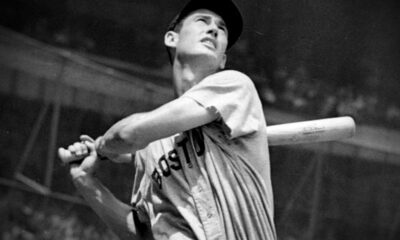

Features
/ 10 hours agoDeep Dive into Ted Williams and the Red Seat Home Run
The home run Ted Williams hit on June 9, 1946, is marked to this...
-
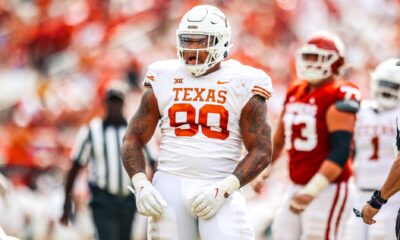

College Football
/ 22 hours agoNFL Draft 2024 Scouting Report: Byron Murphy II, DT, Texas
Byron Murphy II, DT, Texas Height: 6’0 ½” Weight: 297 Arm Length: 32...
-
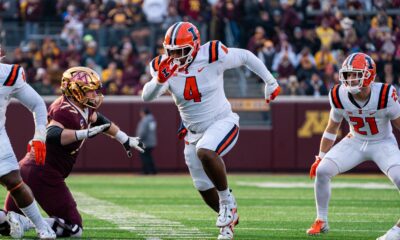

College Football
/ 22 hours agoNFL Draft 2024 Scouting Report: Jer’Zhan Newton, DT, Illinois
Jer’Zhan Newton, DT, Illinois Height: 6’2” Weight: 304 Arm Length: 32 ⅜ ...
-
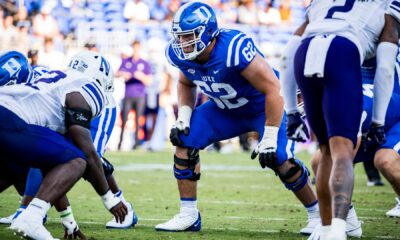

College Football
/ 23 hours agoNFL Draft 2024 Scouting Report: Graham Barton, OT, Duke
Graham Barton, OT, Duke Height: 6’5” Weight: 313 Arm Length: 32 ⅞ ...
